The Ultimate Guide to Beer Kegs: Keg Sizes, Dimensions, Weights, and How Many Beers Are In Each Type of Keg
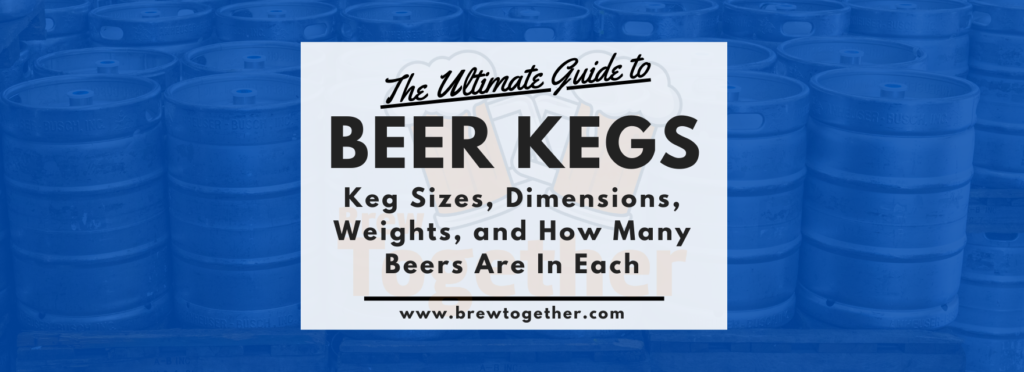

Beer comes packaged in all shapes and sizes. From cans, to bottles, to kegs, there’s an option to purchase almost any amount of beer that your heart (or, more accurately, your liver and wallet) desires. Because there are so many keg sizes available, it can be confusing to know exactly how much beer you’re getting when you buy it by the keg to have draft beer at home.
To make comparing the various sizes of kegs easier, we put together this handy guide and some easy to follow infographics. Now you can easily tell everything you need to know about each size keg based on standard U.S. keg size measurements, including their dimensions, weights, and how many beers fit in each.
Worried about your beer going bad? Check out our guide to how long beer lasts in a keg, with tips and tricks for keeping your beer fresh longer!
What is a Barrel or BBL in Beer?
Before we get to the sizes of kegs, we need to talk about how beer is measured. In the United States, beer production is measured in “beer barrels”, or BBL for short. The BBL is the official unit of measurement for beer volume- for breweries in the United States,; and it is written as “beer barrel” or BBL.
How Many Gallons, Ounces, and U.S. Pints are in a Beer Barrel?
One full barrel of beer, or BBL, is equal to 31 U.S. gallons, which equals:
- 2 x “Standard” Half Barrel Kegs (½ BBL)
- 4 x Quarter Barrel Kegs
- 6 x Sixth Barrel Kegs
- 6 x Homebrew (Corny) Kegs
- 23½ x Mini Kegs
- 82⅔ x 48oz pitchers
- 62 x 64oz growlers (Not sure what a growler is? Click here to check out our Guide to Growlers!)
- 66 x 60oz pitchers
- 124 x 32oz growlers
- 124 x 32oz pitchers
- 248 x 16-ounce Pints
- 330 x 12oz Beers (12-ounce Bottles or 12-ounce Cans)
Note that there is a difference between a US gallon and an imperial gallon (imp gal). An imperial gallon is equal to 160 fluid ounces (fl oz), while a US gallon is equal to 128 oz.


How Many Barrels of Beer Do Breweries Produce?
There is a huge variation in how many BBL breweries produce. Large domestic breweries, like Budweiser have automated brewing systems that produce hundreds of BBL per batch. Even large craft breweries like Sierra Nevada can produce over 100 BBL per batch of beer. To be considered a craft brewery in the United States, the brewery must produce less than 6,000,000 barrels of beer per year (which is 186,000,000 US gallons of beer, or about 1,488,000,000 pints for those keeping score).
Microbreweries, a smaller subset of craft breweries, must brew less than 15,000 barrels of beer per year, which is 465,000 US gallons of beer, or about 3,720,000 pints of beer. Microbreweries range some in the batch size they produce. Most range between 30 and 50 BBL systems, but there are microbreweries that brew as little as 1-2 BBL at a time on systems like this. If you want to learn more about the differences between craft beer and domestic beer, click here to check out our Guide to Craft Beer vs Domestic Beer vs Imported Beer.
What is a Sanke Keg?
Before we get into the sizes of kegs, let’s talk about the overall style. Most of the kegs on this list (and most standard kegs in general), are known as Sanke kegs. Sanke kegs or Sankey kegs (short for sanitary key) are the standard stainless steel keg for storing, distributing, and dispensing commercial beer. Snake kegs are generally made from 100% stainless steel. Unlike the kegs commonly used by homebrewers, Sanke beer kegs have a single valve on the top of the keg that allows both the gas to enter the keg and the beer to exit the keg.
The opening in the keg allows for a long metal tube, called the spear, to run from the top of the keg where it connects to the draft system to the bottom of the keg where it pulls the beer from. The carbon dioxide (CO2) or Nitrogen flows through the valve into the top of the keg (the headspace) and pushes the beer downward, where it is drawn into the spear and up and out of the keg.
Keg taps for Sanke kegs include a special sankey coupler, which is a sanitary key (called a sankey) that opens the special snake valve so that gas can enter the keg and beer can exit the keg through the valve. There are a few different types of couplers for sanke kegs depending on their country of origin:
- D-Style Sanke Couplers are used for sanke kegs from the United States
- S-Style Sanke Couplers are used for most sanke kegs from Europe
- A-Style Sanke Couplers are used for most sanke kegs from Germany
- U-Style Sanke Couplers are used for some sanke kegs from Europe that the S-style does not work with.


Common Types of Kegs
There are several common types of kegs, each of which has its own specific size, shape, capacity, and coupler type. The different sizes of kegs each have a different use, and this guide will help beer lovers choose the right keg of their favorite beer based on their individual needs.
We’ll discuss each in detail, but here’s a handy comparison chart to help you quickly see the differences in each keg’s size, shape, capacity, common uses, empty keg weight, full keg weight, average cost, and the number of beers that fit in each:
Mini Kegs
Mini kegs, sometimes called a bubba keg or a 5l keg, are essentially large, pressurized cans of beer. These smaller kegs are designed for one-time use with or without mini kegerators, and are often brought to parties or homes instead of cans or bottles of beer. 5 liter mini kegs hold 1.32 gallons of beer (169 ounces of beer) of beer, which is equivalent to about 10 and ½ 16oz pints of beer, or about 14 12-oz bottles or cans.
While they can be dispensed right from the keg using the provided tap when buying mini keg beers, using a mini kegerator can improve the experience and shelf life. Having a convenient kegerator on a kitchen counter that is always stocked with 5 liter mini-kegs and uses only CO2 cartridges to serve the beer and electricity to keep the beer in a cool place and out of direct sunlight. 5l mini kegs can be purchased empty from homebrew supply stores for use with small batch homebrewed beer as well.
Mini kegs are widely available in liquor stores and grocery stores, but the best selection will be at a specialty craft beer store. The most commonly seen brand of the many available 5 liter kegs is Heiniken, and the popular 5l Heineken mini keg established these kegs as a commonly available method for serving beer at small parties.
Other brands that distribute their beer in mini kegs, including several popular European beer brands, include Newcastle Brown Ale, Coors Light Lager, Warsteiner Premium Pilsener, Paulaner Oktoberfest Marzen Amber, Widmer Hefeweizen, Heineken Light, Rogue Yellow Snow IPA, Bitburger Premium Pilsner,Spaten Premium Lager, Einbecker Pils, Hofbrau Original, Bell’s Oberon Ale, and Hofbrau Oktoberfestbier. A larger liquor store should have at least a few options.
The main drawbacks of mini kegs are that they are intended for one time use and that their availability can be limited. Unlike the other types of kegs on this list, mini kegs are not reusable and are intended to store and serve only the beer that comes with the keg (that is, unless you’re James! Check out his DIY mini keg system on the BrewTogether Forums!). They’re a good alternative to a six pack for bringing to a party, camping, etc, but they haven’t caught on as a popular way to sell, distribute, or consume beer on a large scale.
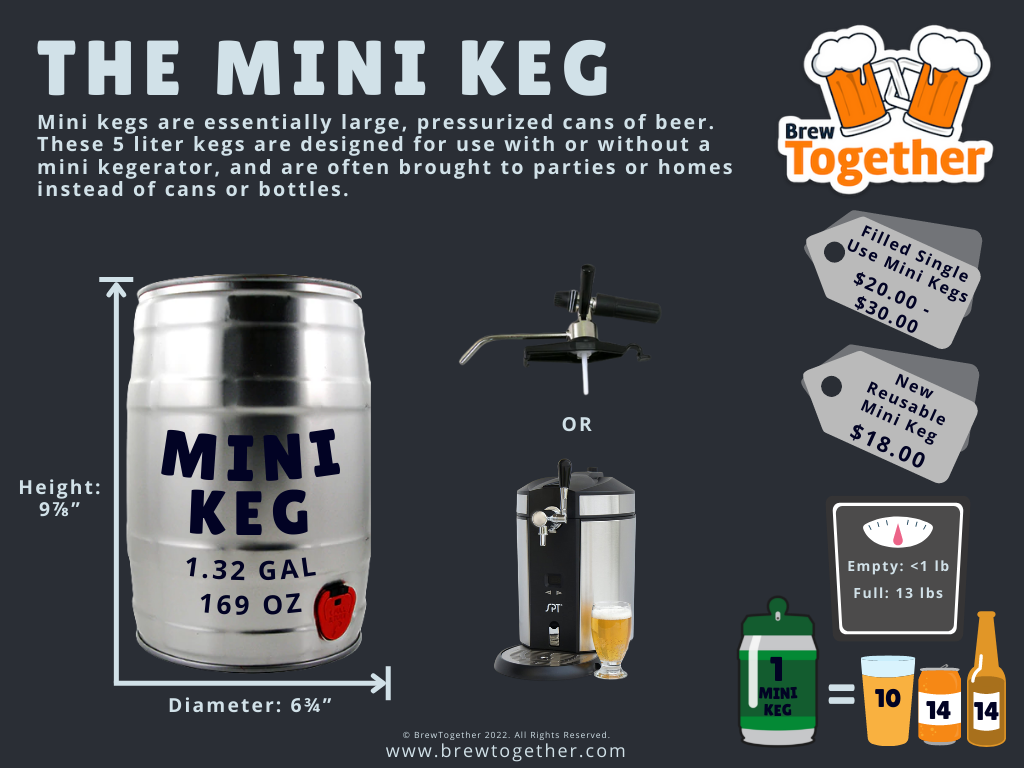

Cornelius Kegs / Corny Kegs
Cornelius kegs, more commonly called “Corny Kegs”, were originally soda kegs used by soft drink manufacturers to distribute their beverages for onsite consumption. Later, when soft drink companies switched to a syrup concentrate that is mixed with carbonated water for use in restaurants, corny kegs became a popular choice for homebrewers to store and serve their beer.
Corny kegs are a favorite of homebrewers because the standard ones have a 5 gallon capacity, which is a standard homebrewing batch size, and they are easy to clean and maintain. Unlike most of the types of kegs used by commercial breweries, corny kegs have a removable lid and require few if any special tools. They also have a relatively low cost, including the cost of the lines and quick disconnects needed for home kegerators or keezers. A corny keg weighs about 14 lbs empty, and about 58 lbs filled.
Ball Lock vs Pin Lock Corny Kegs


The original cornelius kegs came in two slightly different sizes based on which brand they were for. Pepsi and Coca-Cola products both came in corny kegs. Pepsi opted for a slightly taller and slimmer keg with ball lock posts. Coca-Cola used a slightly shorter, wider keg with pin lock posts.
Ball lock corny kegs are the most common type now, and are also the ones that you’re most likely to find available new. While they lack a few advantages of the pin lock (like the inability to accidentally put the disconnects on backwards), they are overall a bit more convenient and inexpensive to maintain. Ball lock corny kegs, like those originally used by Pepsi, are taller and slimmer than pin lock kegs at 25” tall and 85” wide. The posts on a ball lock keg are designed so that the quick disconnects can be pressed on to lock them into place using a set of ball bearings.
Pin lock corny kegs, like those used by Coca-Cola, are shorter and have a larger width than ball lock kegs, with a height of about 22” and a width of about 9”. The posts on a pin lock keg have a pin that fits into a channel on the disconnect that locks it into place when the keg is in use. Additionally, pin lock keg posts are different sizes for the gas line and the beer line (2 pins gas in post, 3 pins on the liquid out post). This means that you cannot accidentally put them on backwards, which is a potential hazard of ball lock kegs.
While you can buy replacement lids that fit either type of corny keg (and the lids are generally interchangeable between the two styles), one big advantage of the original ball lock kegs was a manual pressure release valve in the lid, which allows the user to release the pressure in the keg safely and without any tools. Any homebrewer who kegs will tell you that having a pressure release valve is a great feature for safety and convenience! If you’re going to buy pin lock corny kegs, we recommend buying one of these replacement lids with a PRV included.
While one isn’t necessarily better than the other, if you’re planning on setting up a home draft system for your homebrew, you’ll need to make sure you get the right quick disconnects for the type you purchase. Additionally, make sure you consider the slight difference in dimensions to ensure that the kegs fit in your kegerator or keezer.
While it’s still possible to find old soda kegs, it has gotten harder to find them over the last decade and most homebrewers now buy new corny kegs. While traditionally corny kegs have had a 5 gallon capacity, you can now buy other sizes of corny kegs, including:
If you’ve decided on corny kegs, but aren’t sure how to maintain them, check out our guide to how to clean a corny keg, step-by-step, or build one of our DIY keg and carboy washers!
Sixth Barrel Kegs (1/6 BBL Kegs)
Sixth barrel kegs, sometimes called Sixtels, Torpedo Kegs, or Log Kegs, are smaller sankey-style kegs that are a common beer keg used in a dual-tap kegerator and for homebrewing. These kegs are commonly the ones that homebrewers upgrade to when they discontinue using cornelius kegs. They’re the same exact keg as a standard half-barrel sanke keg, except that they hold 5.16 gallons (approximately the size of a standard Cornelius keg). Because they are sanke kegs, a sixtel keg requires a sankey coupler (most available in the U.S. are compatible with a D-style coupler) to use with a home kegerator.
Sixth barrel kegs are 23⅜” tall and 9¼” in diameter. They weigh about 14lbs empty and the full keg weight of a sixth barrel keg is about 58lbs. They hold 5.16 gallons (661 ounces), which is ⅙ the capacity of a beer barrel. This means that each sixth barrel keg holds 55 12-oz cans/bottles or 41⅓ pints of beer.
A new sixth barrel sanke keg costs between $100 and $140 online and are commonly used by home brewers. Beer purchased by the sixth barrel keg ranges from about $65 to $85 for domestics, but craft beers can range from $75 all the way up to $200 per sixth barrel keg.
Please note that purchasing beer by the keg does not mean you bought the keg. The keg deposit you pay when purchasing kegged beer does not entitle you to the keg, and keg theft is a huge problem for craft breweries. Please return your kegs!
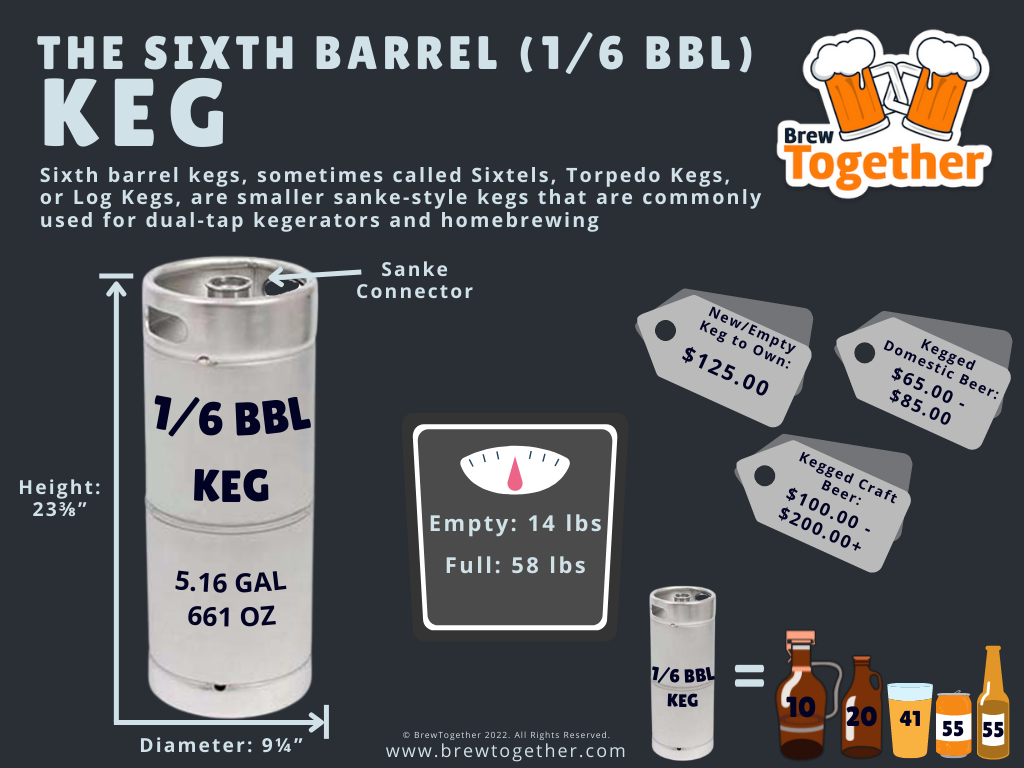

Quarter Barrel Kegs (1/4 BBL Kegs)
Quarter Barrel Kegs come in two different sizes, but have the same capacity. Standard quarter barrel kegs are short and wide, with a height of 13⅞” and a diameter of 16⅛”. A slim quarter keg or tall quarter keg, on the other hand, is taller and thinner, with a height of 23⅜” and a diameter of 11⅛”. Both slim quarter kegs and stubby quarter kegs have a capacity of 7.75 gallons (992 ounces), which equals 62 16-oz pints, or about 82 and ⅔ 12-oz bottles or cans. They have an empty weight of about 19 lbs, and a full pony keg weighs about 90lbs.
A new quarter barrel keg costs about $150. When purchasing beer by the quarter barrel keg, expect to spend an average of about $90-$120 for domestics, but up to $250 for high-quality craft beers. Remember, purchasing beer by the keg does not mean you bought the keg itself, and it should be returned to where you purchased the beer.
Both styles of quarter barrel keg are often used for dual-tap kegerators; small parties, and are a great choice for bars and restaurants that want to have more beer options on tap, but do not have enough space for full kegs of each. Quarter barrel kegs are often referred to as a Pony Keg, ¼ barrel keg, ¼ keg, or Stubby Quarter.
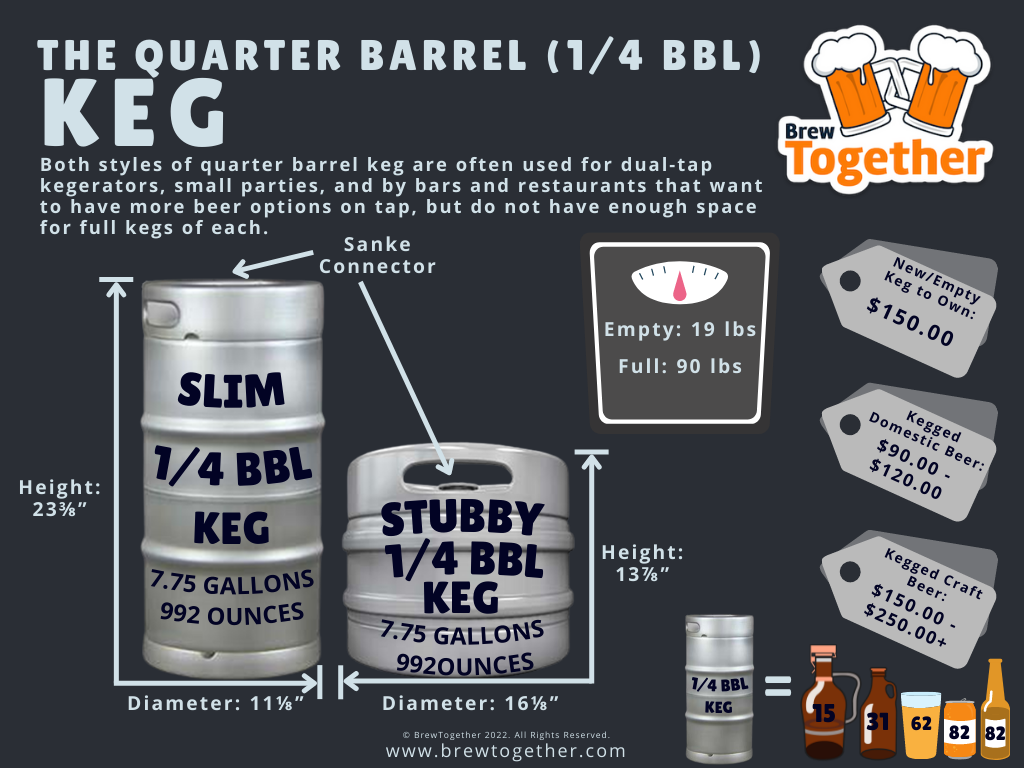

Half Barrel Kegs (1/2 BBL Kegs)
Half barrel kegs are the most common type of keg and probably what you think of when you hear the word “keg”. A half-barrel keg is generally considered to be the standard keg. They are the main keg size used for distribution to bars, taprooms, and restaurants. Half barrel kegs are also often used for home bars (standard kegerators are usually made to work specifically with half barrel kegs), large events, business functions, large parties, and, of course, frat parties.
Half barrel kegs are the largest standard keg size. A full half keg stands 23⅜” tall and has a diameter of 16⅛”. They hold 15.5 gallons (1984 oz), which translates to 124 16-oz pints or about 165⅓ 12-oz bottles or cans. Empty, a half barrel keg weighs about 30 lbs. A full half barrel keg weighs about 160lbs, making them a challenge to carry.
Purchasing a new half barrel keg will set you back about $180. Purchasing beer by the half barrel keg ranges from about $150 – $200 for domestic beers, while craft options range from about $225 to over $300 on average.
While there are many nicknames for most of the types of kegs on this list, the half barrel keg is considered to be the full-size keg and the only one consistently known as “keg”.


How Much Does Beer Weigh?
Beer comes in all shapes, sizes, and servings of beer. Beer can be commonly bought in cans, bottles, 6-packs, 12-packs, cases of beer, and even different sized stainless steel kegs. For practical purposes beer weighs very close to the same amount per volume as water, so the consideration about how much beer weighs mostly centers around the volume and the weight of the container it is stored in. For example, a full size keg, weigh 30 pounds empty, and hold an additional 130 pounds of beer, making the full keg weight of a half barrel keg 160 pounds.
This chart helps make the comparison of how much each of the various size containers of beer weigh empty and full easier:
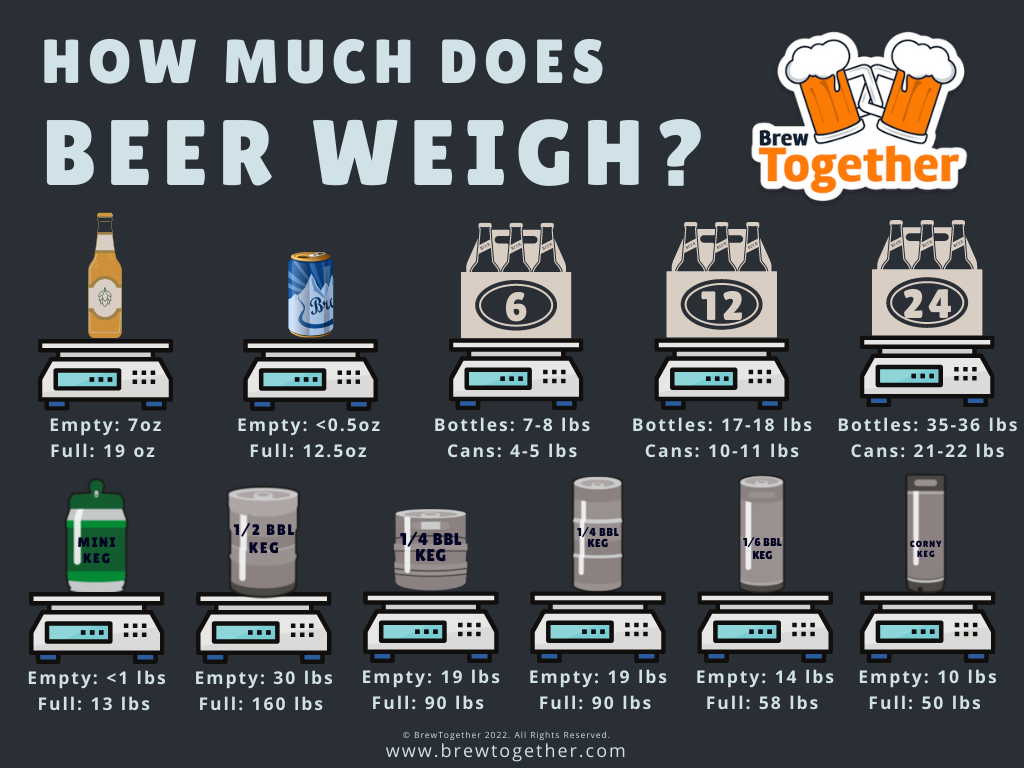

How Much Does a Keg of Beer Weigh?
There are several sizes of keg (see the earlier sections of this article for full keg sizing information), each with its own size and weight:
- Mini Kegs weigh under 1 lb empty and about 13 lbs filled.
- Cornelius Kegs weigh about 10 lbs empty and about 50 lbs filled.
- Sixth Barrel Kegs weigh about 14 lbs empty and about 58 lbs filled.
- Quarter Barrel Kegs weigh about 19 lbs empty and about 90 lbs filled.
- Half Barrel Kegs weigh about 30 lbs empty and about 160 lbs filled.
How Much Do Beer Cans Weigh?
Standard 12 oz aluminum beer cans weigh just under ½oz empty on average. Filled 12 oz aluminum beer cans weigh about 12½ oz on average. The weight of the beer in a 12-oz can, not including the weight of the bottle, is 12 oz on average, but varies very slightly based on the density of the beer. Generally, beer has a close enough density to water to use standard water fl-oz to oz conversions.
How Much Do Glass Beer Bottles Weigh?
Standard 12oz bottles usually weigh between 6-7 oz empty, depending on the brand and manufacturer. Filled 12 oz glass beer bottles weigh about 18-19 oz on average. The weight of the beer in a 12-oz bottle, not including the weight of the bottle, is approximately 12 oz.
16-oz glass beer bottles, which are a bit less common, usually weigh about 9-10 oz empty. Filled 16 oz glass beer bottles weigh about 25-26 oz on average. The weight of the beer in a 16-oz bottle, not including the weight of the bottle, is approximately 16 oz.
Bomber bottles, which are 22-oz beer bottles, weigh about 10-13 oz empty on average, depending on the brand and manufacturer. Filled bomber bottles weigh about 32-35 oz on average. The weight of the beer in a 22-oz bomber bottle, not including the weight of the bottle, is approximately 22 oz.
How Much Does a 6-Pack of Beer Weigh?
6-packs of beer are commonly available in both cans and bottles. The weight of a 6-pack of beer is different based on whether the beer is packaged in cans or bottles. A 6-pack of bottled 12-oz beers weighs about 7 – 8lbs on average. A 6-pack of canned 12-oz beers weighs about 4 – 5 lbs.
How Much Does a 12-Pack of Beer Weigh?
Like a case, the weight of a 12-pack of beer is different based on whether the beer is packaged in cans or bottles. A 12-pack of bottled 12-oz beers weighs about 17 – 18 lbs. A 12-pack of canned 12-oz beers weighs about 10 – 11 lbs.
How Much Does a Case of Beer Weigh?
The weight of a case of beer depends on whether the beer is packaged in bottles or cans. Because bottles weigh substantially more than cans, 24-packs of bottles weigh more than 24-packs of cans. A case of 24 bottled 12-oz beers weighs about 35 – 36 lbs on average. A case of 24 canned 12-oz beers weighs about 21 – 22 lbs.
Conclusion
As you can see, there are several types of kegs, and they come in many sizes and shapes. Each has its own specific use, but they all have one thing in common: the delicious beer inside! So, now that you know all about kegs, grab yourself a beer to celebrate! Just don’t remember to return the keg to the brewery when you’re done! Cheers!
Thanks for Reading!
Still have questions about kegs or anything else beer and brewing related? Leave a comment below or post in the forums! The BrewTogether Community is made up of an awesome group of homebrewers around the world that are always supportive and happy to help answer your questions!
Thank you for reading! If you like this article, please share it with your friends using the social media share buttons below! We need your help getting the word out about BrewTogether!
If you’re not a member of BrewTogether, we’d love for you to join! BrewTogether is completely free, and signing up is easy! Click here to join! We’d love to have you as a member of the BrewTogether Community!
Now using BrewTogether is easier than ever! Download the FREE BrewTogether Mobile App – available on both the Apple App Store and the Google Play Store! The BrewTogether App is completely free and drastically improves the experience of using BrewTogether on a mobile device.
Affiliate Disclosure: BrewTogether is a participant in the Amazon Services LLC Associates Program, an affiliate advertising program designed to provide a means for us to earn fees by linking to Amazon.com and affiliated sites. BrewTogether is also a participant in an affiliate program with MoreBeer, our favorite online homebrewing equipment/ingredients retailer. Some of the links in this article are affiliate links, which means that if you choose to make a purchase after clicking the link, I will earn a small commission at no additional cost to you. Please feel free to reach out with questions. Thank you for your support!

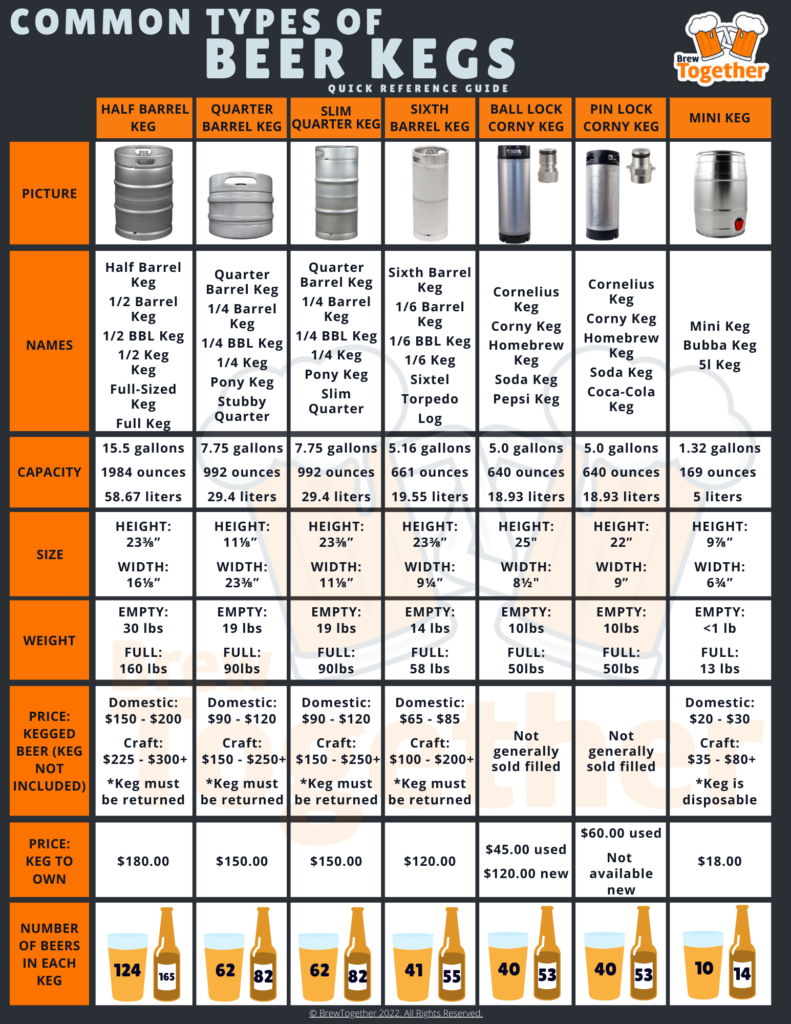
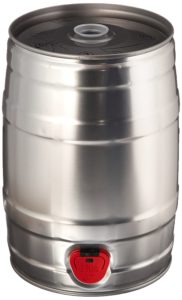


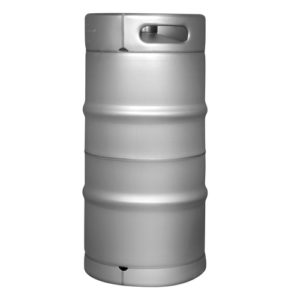

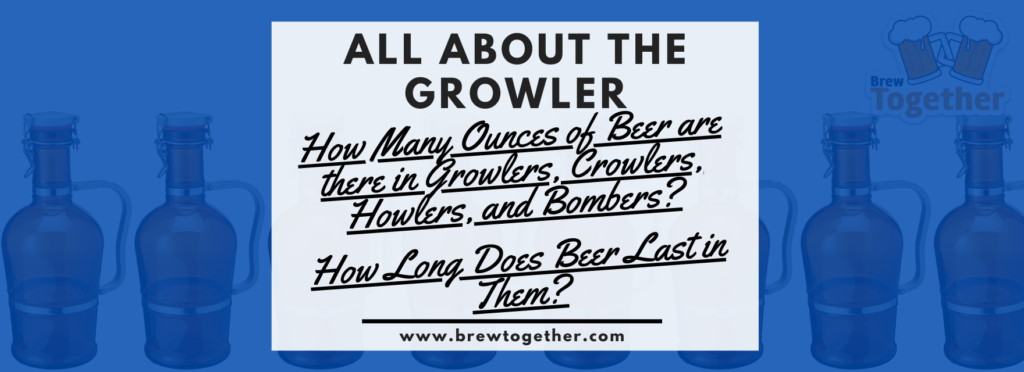



[…] BrewTogether.com also offers an informative guide – The Ultimate Guide to Beer Keg Sizes, Dimensions, Weights, and Number of Beers in Each Type. […]
[…] cost of a half-barrel keg of Bud Light ranges from $79 to $139, depending on the market. One of the tallest kegs is a stubby quarter barrel, which measures about 14 inches in […]
[…] Retrofits can be performed at any time if the machine’s exterior keg washer is installed. All standard keg shapes and sizes, from the 10-liter to the 58-liter, can be processed by the Innokeg Till […]
[…] wide, and it will keep you and your friends entertained for hours. Half barrel kegs are the largest standard size kegs on the market. This large (15,984 oz) keg is 23 3/8″ tall and has a diameter of 16″, […]
[…] Mini kegs function similarly to full-sized kegs in that they require less settling time. The maximum keg size is 5 liters, and it is the equivalent of 14 standard beer cans or 10 pints of beer. Pony kegs […]
[…] keg of beer in 11 gallons typically contains about 50 liters, or 5.2 pints. The most common commercial keg size is a 1/6 keg, which holds 19.8 liters of […]
[…] in size. The weight should be at the top of your list of concerns as well. The weight of most kegs ranges between 80 and 100 […]
[…] of beer that contains an identification number. Each state’s minimum volume requirements for beer kegs range from 2 to 8 gallons. There is insufficient evidence to determine whether laws requiring keg […]